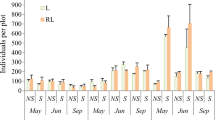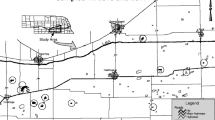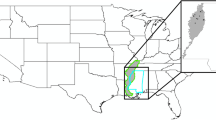Abstract
Intensive management of wetlands to improve wildlife habitat typically includes the manipulation of water depth, duration, and timing to promote desired vegetation communities. Increased societal, industrial, and agricultural demands for water may encourage the use of alternative sources such as wastewater effluents in managed wetlands. However, water quality is commonly overlooked as an influence on wetland soil seed banks and soils. In four separate greenhouse trials conducted over a 2-yr period, we examined the effects of municipal wastewater effluent (WWE) on vegetation of wetland seed banks and soils excavated from a wildlife management area in Missouri, USA. We used microcosms filled with one of two soil materials and irrigated with WWE, Missouri River water, or deionized water to simulate moist-soil conditions. Vegetation that germinated from the soil seed bank was allowed to grow in microcosms for approximately 100 d. Vegetative taxa richness, plant density, and biomass were significantly reduced in WWE-irrigated soil materials compared with other water sources. Salinity and sodicity rapidly increased in WWE-irrigated microcosms and probably was responsible for inhibiting germination or interfering with seedling development. Our results indicate that irrigation with WWE promoted saline-sodic soil conditions, which alters the vegetation community by inhibiting germination or seedling development.
Similar content being viewed by others
Literature Cited
Al-Karaki, G. N. 2001. Germination, sodium, and potassium concentrations of barley seeds as influenced by salinity. Journal of Plant Nutrition 24: 511–522.
Ayers, A. D. 1951. Seed germination as affected by soil moisture and salinity. Agronomy Journal 44: 82–84.
Baskin, C. C. and J. M. Baskin. 1998. Seeds, Ecology, Biogeography, and Evolution of Dormancy and Germination. Academic Press, London, UK.
Bewely, J. D. and M. Black. 1982. Physiology and Biochemistry of Seeds in Relation to Germination, Vol 2. Springer-Verlag, Berlin, Germany.
Blanchar, R. W. 2000. The effects of effluent as a water source for managed wetlands at Eagle Bluffs CA. p. 1–32. In D. A. Graber (ed.) Baseline characteristics of soils at the Eagle Bluffs Wildlife Area prior to effluent use: nutrient transformation in similar substrates and plants with effluent and Missouri River water as a water source. Missouri Department of Conservation Federal Aid Project No. W-13-R-54(2000), Study No. 3, Job. No. 3. Missouri Department of Conservation, Columbia, MO, USA.
Bliss, R. D., K. A. Platt-Aloia, and W. W. Thomson. 1984. Effects of salt on cell membranes of germinating seeds. California Agriculture 38: 24–25.
Bohn, H. L., B. L. McNeal, and G. A. O’Connor. 2001. Soil Chemistry. John Wiley & Sons, Inc., New York, NY, USA.
Brock, M. A., D. L. Nielsen, and K. Crossle. 2005. Changes in biotic communities developing from freshwater wetland sediments under experimental salinity and water regimes. Freshwater Biology 50: 1376–90.
Cain, S. A. and G. M. de Oliveira Castro. 1959. Manual of Vegetation Analysis. Harper & Brothers, New York, NY, USA.
Davies, S., J. Nuttall, R. D. Armstrong, and M. Peoples. 2004. Assessing the impact of high soil boron and salinity on the root growth of potential primer-plant species. Proceedings of the 4th International Crop Science Congress Brisbane, Australia, 26 Sep.–1 Oct. 2004.
Day, P. R. 1965. Particle fraction and particle-size analysis. p. 545–67. In C. A. Black (ed.) Methods of Soil Analysis, Part 1. Agronomy Monographs. No. 9. American Society of Agronomy, Inc., Madison, WI, USA.
DiTommaso, A. 2004. Germination behavior of common ragweed (Ambrosia artemisiifolia) populations across a range of salinities. Weed Science 52: 1002–09.
EPA. 2002. National water quality inventory: report to congress. EPA 841-R-07-001. United States Environmental Protection Agency, Office of Water, Washington, DC, USA.
Finlayson, M., P. Cullen, D. Mitchell, and A. Chick. 1986. An assessment of a natural wetland receiving sewage effluent. Australian Journal of Ecology 11: 33–47.
Finocchiaro, R. G. and R. J. Kremer. 2009. Effect of municipal wastewater as a water source on soil microbial activity. Communications in Soil Science and Plant Analysis. In press.
Foderaro, M. A. and I. A. Ungar. 1997. Growth and survival of Polygonum aviculare L. at a brine-contaminated site in southeastern Ohio. American Midland Naturalist 138: 140–52.
Fredrickson, L. H. and T. S. Taylor. 1982. Management of seasonally flooded impoundments for wildlife. Fish and Wildlife Service Resource Publication 148, U.S. Department of Interior, Washington, DC, USA.
Flynn, K. M., K. L. McKee, and I. A. Mendelssohn. 1995. Recovery of freshwater marsh vegetation after a saltwater intrusion event. Oecologia 103: 63–72.
Gul, B. and D. J. Weber. 1998. Effect of dormancy relieving compounds on the seed germination of non-dormant Allenrolfea occidentalis under salinity stress. Annals of Botany 82: 555–60.
Havera, S. P., A. P. Yetter, C. S. Hine, and M. M. Georgi. 1996. Land management for waterfowl in the Illinois and Mississippi floodplains. Illinois Natural History Survey, Survey Document 2154, Champaign, IL, USA.
Havlin, J. L., J. D. Beaton, S. L. Tisdale, and W. L. Nelson. 1999. Soil Fertility and Fertilizers, sixth edition. Prentice Hall, Upper Saddle River, NJ, USA.
Kadlec, R. H. 1981. How natural wetlands treat wastewater. p. 241–54. In B. Richardson (ed.) Selected Proceedings of the Midwest Conference on Wetland Values and Management. Freshwater Society, Navarre, MN, USA.
Kantrud, H. A., J. B. Millar, and A. G. van der Valk. 1989. Vegetation of wetlands of the prairie pothole region. p. 132–87. In A. G. van der Valk (ed.) Northern Prairie Wetlands. Iowa State University Press, Ames, IA, USA.
Khan, M. A. and I. A. Ungar. 1999. Effect of salinity on seed germination of Triglochin maritime under various temperature regimes. Great Basin Naturalist 59: 144–50.
Klute, A. 1986. Water retention: laboratory methods. p. 636–50. In A. Klute (ed.) Methods of Soil Analysis, Part 1, second edition. Agronomy Monographs. No. 9. American Society of Agronomy, Inc., Soil Science Society of America, Inc., Madison, WI, USA.
Knowlton, M. F. and J. R. Jones. 2003. Fecal bacteria, nutrients, chlorophyll, and dissolved oxygen in a constructed habitat wetland receiving treated municipal effluent and river water. Lake and Reservoir Management 19: 171–83.
Laubhan, M. K., S. L. King, and L. H. Fredrickson. 1996. Managing wetlands for wildlife. p. 623–647. In T. A. Bookhout (ed.) Research and Management Techniques for Wildlife and Habitats. fifth edition. The Wildlife Society, Bethesda, MD, USA.
Lieffers, V. J. and J. M. Shay. 1983. Ephermeral saline lakes on the Canadian prairies: their classification and management for emergent macrophyte growth. Hydrobiologia 105: 85–94.
Macharia, J. N. M., J. Kamau, J. N. Gituanja, and E. W. Matu. 1995. Effects of sodium chloride salinity on seed germination, and seedling root and shoots extension growth of four Sorghum bicolor cultivars. Discovery and Innovation 7: 187–94.
Mamo, T., C. Richter, and B. Heiligtag. 1996. Salinity effects on the growth and ion contents of some chickpea (Cicer arietinum L.) and lentil (Lens culinaris Medic.) varieties. Journal of Agronomy & Crop Science 176: 235–47.
Mansour, M. M. F. 1994. Changes in growth, osmotic potential, and cell permeability of wheat cultivars under salt stress. Biologia Plant 36: 429–34.
Milliken, G. A. and D. E. Johnson. 1984. Analysis of messy data, volume I: designed experiments. Van Nostrand Reinhold Company, New York, NY, USA.
Mudroch, J. A. and A. Capobianco. 1979. Effects of treated effluent on a natural marsh. Journal of Water Pollution Control Federation 51: 2243–56.
Oster, J. D. 1982. Gypsum usage in irrigated agriculture: a review. Fertilizer Research 3: 73–89.
Pearce-Pinto, G. V. N., P. G. Van Der Moezel, and D. T. Bell. 1990. Seed germination under salinity stress in Western Australian species of eucalyptus. Seed Science & Technology 18: 113–18.
Qadir, M., R. H. Qureshi, and N. Ahmad. 1996. Reclamation of saline-sodic soil by gypsum and Leptochloa fusca. Geoderma 74: 207–17.
Rahman, M. and I. A. Ungar. 1990. The effect of salinity on seed germination and seedling growth of Echinochloa-crusgalli. Ohio Journal of Science 90: 13–15.
Richards, J. M. 1999. Hydrological data for the Columbia/Eagle Bluffs Wetland Complex, Columbia, Missouri, 1993–96. U.S. Geological Survey Open-File Report 99-607. United States Department of the Interior, United States Geological Survey, Denver, CO, USA.
Richards, L. A. 1954. Diagnosis and improvement of saline and alkaline soils. Agricultural Handbook No. 60. U.S. Department of Agriculture. United States Government Printing Office, Washington, DC, USA.
SAS Institute. 2002–2003. SAS user’s guide: statistics, version 9.1. SAS Institute, Cary, NC, USA.
SSL Methods Manual. 2004. Soil survey laboratory methods manual. Soil Survey Investigations Report No. 42. Version 4.0. U.S. Department of Agriculture, Natural Resources Conservation Service, National Soil Survey Center, Lincoln, NE, USA.
Stader, R. E. and P. H. Stinson. 2005. Moist-soil management guidelines for the U.S. Fish and Wildlife Services southeast region. Migratory Bird Field Office. Division of Migratory Birds Southeast Region. U.S. Fish and Wildlife Service, Jackson, MS, USA.
Steyermark, J. A. 1963. Flora of Missouri. The Iowa State University Press, Ames, IA, USA.
Stewart, R. E. and H. A. Kantrud. 1972. Vegetation of prairie potholes, North Dakota, in relation to quality of water and other environmental factors. U.S. Geological Survey Professional Paper 585-D.
Sumner, M. E. and R. Naidu. 1998. Sodic Soils: Distribution, Properties, Management, and Environmental Consequences. Oxford University Press, New York, NY, USA.
ter Braak, C. J. F. and P. Smilauer. 2002. CANOCO reference manual and CanoDraw for Windows user’s guide: software for canonical community ordination, version 4.5. Microcomputer Power, Ithaca, NY, USA.
Toze, S. 2005. Reuse of effluent water-benefits and risks. Agricultural Water Management 80: 147–59.
Ungar, I. A. 1995. Seed germination and seed-bank ecology in halophytes. p. 599–628. In J. Kigel and G. Galili (eds.) Seed Development and Germination. Marcel Dekker, New York, NY, USA.
USDA, NRCS. 2008. The PLANTS database (http://plants.usda.gov, 19 February 2008). National Plant Data Center, Baton Rouge, LA, USA.
USGS. 1998. Hydrological data for the Columbia/Eagle Bluffs Wetland Complex, Columbia, MO, 1993–96. Water-Resources Open-File Report 98-1998. United States Department of the Interior, United States Geological Survey, Denver, CO, USA.
USGS Missouri River Water Quality Data Base. 2006. Water quality data of the Missouri River at Saint Joseph, Missouri, during the periods of 1 January, 1997–1 January, 2003. http:// waterdata.usgs.gov/mo/nwis/qw. Access 15 February, 2006.
Walsh, G. E., D. E. Weber, M. T. Nguyen, and L. K. Esry. 1991. Response of wetland plants to effluents in water and sediment. Environmental and Experimental Botany 31: 351–58.
Wareing, P. F. and H. A. Foda. 1957. Growth inhibitors and dormancy in Xanthium seed. Physiologia Plantarum 10: 226–80.
Whitney, D. A. 1998. Soil salinity. p. 59–60. In J. R. Brown (ed.) Recommended Chemical Soil Test Procedures for the North Central Region. North Central Regional Research Publication No. 221 (revised). Missouri Agricultural Station SB 1001. Missouri Agricultural Station, Columbia, MO, USA.
Xiong, L. and J. Zhu. 2002. Salt tolerance. p. 1–22. In C. R. Somerville and E. M. Meyerowitz (eds.) The Arabidopsis Book. American Society of Plant Biologists, Rockville, MD, USA. DOI: 10.1199/tab.0048, www.aspb.org/publications/ arabidopsis/.
Yatskievych, G. 1999. Steyermark’s Flora of Missouri. Volume 1. The Missouri Botanical Garden Press, St. Louis, MO, USA.
Young, F. J., C. A. Radatz, and C. A. Marshall. 2003. Soil survey of Boone County, Missouri. United States Department of Agriculture, Natural Resource Conservation Service. In cooperation with Missouri Department of Natural Resources, Missouri Agricultural Experimental Station, and U.S. Department of Agriculture, Forest Service.
Author information
Authors and Affiliations
Corresponding author
Rights and permissions
About this article
Cite this article
Finocchiaro, R.G., Kremer, R.J. & Fredrickson, L.H. Impact of municipal wastewater effluent on seed bank response and soils excavated from a wetland impoundment. Wetlands 29, 713–723 (2009). https://doi.org/10.1672/08-58.1
Received:
Accepted:
Issue Date:
DOI: https://doi.org/10.1672/08-58.1




